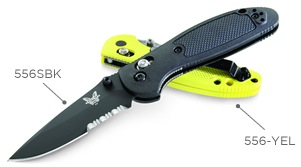What is green?
 Recently bought a Benchmade 556 (the oddly branded “Mini-Griptilian”) for camping and fishing. Indestructible, expensive, nearly as small as a Swiss Army knife, but more useful: bigger, higher-quality, locking blade, a serrated section, and a comfortable non-slip molded handle.
Recently bought a Benchmade 556 (the oddly branded “Mini-Griptilian”) for camping and fishing. Indestructible, expensive, nearly as small as a Swiss Army knife, but more useful: bigger, higher-quality, locking blade, a serrated section, and a comfortable non-slip molded handle.
I come from a dedidedly non-martial family, so it was a reach to buy something that looks at home on a Special Forces commando. But an experience in Anza-Borrego Desert State Park was instructive.
We were headed to a backcountry camp when my truck’s mudflap somehow entangled itself with the tire, bending so that it would rub the tire forever after. I showed this to one of the other drivers, and without a word, he whipped out a small folding knife, and cut off the heavy gauge plastic flap in a single stroke. I was too startled to point out he hadn’t asked for permission, and on reflection, couldn’t think of anything better to do anyway. But the really interesting part was the knife. That single sweep was far beyond the capabilities of the pocketknives I knew about.
That knife was a Benchmade. This is a US-made product that is designed to last almost forever — the vendor will sharpen it free — and this raises an interesting subtlety about green-ness and buying American.
Now, I am NOT a xenophobe or protectionist. Practically everything I own is foreign-made. But it does occur to me that a quality product like Benchmade has an inherently smaller carbon footprint than its far cheaper imported substitutes, for at least 3 reasons. First, it need not be shipped across the ocean. Second, US manufacturing, though more expensive due to labor costs, is actually less energy-intensive than mainland China. Third, since Benchmade will sharpen it for free, for life, you rarely need to replace it.
Of course, greener still would have been to buy it used on eBay. But that would mean detecting cheap counterfeits, and I don’t have the time or expertise for that.
No Comments
No comments yet.
Sorry, the comment form is closed at this time.